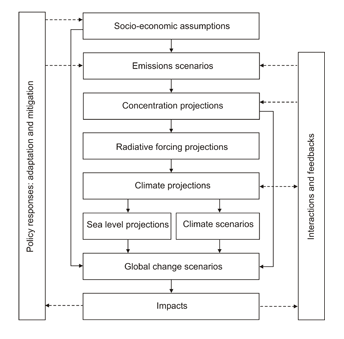|
|
 |  | 
| Print this Brief |
| How
do scientists make projections about future climate
change and climate impacts? |
| |
Key
Points
Scientists generally use several models in combination
with different emissions and development scenarios
to make a range of projections for each climate variable
and to construct multiple global change scenarios.
These scenarios can be used to get a sense of the
direction and relative magnitude of changes in temperature,
precipitation, and other climate variables and can
help define potentially critical thresholds of climate-sensitive
processes. Understanding the range of possible futures
helps policymakers and the general public evaluate
responses.
Climate Change Projections:
A Flow Chart of Processes
Climate change projections are made based on a
flow chart of processes (Figure 1). The flow chart
begins with socioeconomic assumptions that affect
projections of greenhouse gas emissions and ends
with climate system feedbacks and policy. There are
different types of uncertainties associated with
each level of the flow chart, but the interaction
of these uncertainties does not necessarily make
the overall outcome more uncertain.
Socioeconomic Assumptions
Assumptions about population growth, economic growth
and development, and land-use change affect how quickly
scientists think greenhouse gases will be added to
the atmosphere. Future emissions of greenhouse gases
may occur along a range of pathways related to population
and economic growth and technology and land-use change.
Relatively fast economic growth and continued use
of fossil fuels would lead to an increase in greenhouse
gas emissions, while relatively slow economic growth
and an increase in the use of alternative energies
would lead to a decrease in greenhouse gas emissions.
|
|
|
 |
| Figure 1.Cascade of Uncertainties.
With each additional box the uncertainty
increases. Source: Intergovernmental Panel
on Climate Change (IPCC), Working Group I
Third Assessment Report. 2001. |
|
|
 |
| Figure 2. Temperature
change projections for the twenty-first century.
Source:
Intergovernmental Panel on Climate Change
(IPCC), Working Group I Third Assessment
Report. 2001. |
|
|
|
Emissions
Scenarios and Concentration Projections
Figure 2 shows temperatures associated with seven
different carbon dioxide (CO2) emissions
scenarios. The low end of the IPCC range suggests
that in the year 2100 the concentration of CO2 in
the atmosphere would be approximately 550 parts per
million (ppm), or approximately double the pre-industrial
value, while an alternate scenario suggests that
the concentration could be close to 1,000 ppm.
The other five scenarios fall somewhere in between.
Radiative Forcing Projections
While anthropogenic sources of greenhouse gas emissions
are increasing atmospheric concentrations, how the
climate system responds to the higher concentrations,
as well as to other radiative forcings such as sulfate
aerosols and black carbon, is likely to be complex.
For example, an increase in temperatures may cause
an increase in cloud cover. However, the effect of
the additional clouds is uncertain because some types
of clouds are associated with a cooling effect and
other types of clouds are associated with a warming
effect.
Climate Projections
Climate projections depend on emissions scenarios
and on how climate processes and radiative forcing
are modeled. Climate projections include predicted
changes in atmospheric variables such as temperature
and precipitation as well as associated changes in
other components of the climate system - for example
sea-level rise. Temperature projections for the twenty-first
century vary depending on the emissions scenario
and the model used (Figure 2).
Global Change Scenarios
Climate scenarios and sea-level rise projections
can aid scientists as they create global change scenarios
and ask questions such as 'How will the future climate
change?' 'By how much will global temperature rise?'
and 'What will be the consequences?'
Impacts
Impacts are projected based on global change scenarios
often downscaled to regional levels. Impacts are
projected for water, ecosystems, coastal zones, human
settlements and industry, and human health. Projected
impacts vary depending on scenario, sector, and region.
Changes in mean temperature and precipitation as
well as changes in the extremes are important for
the projected impacts.
Interactions and Feedbacks
Feedbacks and interactions among impacts, projections,
and emissions may amplify or dampen climate change.
Policy Responses: Adaptation
and Mitigation
Response to climate change will occur at individual,
regional, and global levels. Adaptation responses
involve adjusting to climate change whereas mitigation
responses involve an intervention to reduce the concentration
of greenhouse gases in the atmosphere.
|
References:
Intergovernmental Panel on Climate Change (IPCC), 2001.
"Working Group I Third Assessment Report." Cambridge
University Press. Cambridge, UK. 881 pp.
Intergovernmental Panel on Climate Change (IPCC),
2001. "Synthesis Report, Third Assessment Report." Cambridge
University Press. Cambridge, UK. 397 pp.
Intergovernmental Panel on Climate Change (IPCC),
2001. "Working Group II Third Assessment Report." Cambridge
University Press. Cambridge, UK. 1032 pp.
Related Resources:
Print version (factsheet
pdf) |
|
 |
 |
| |
|
|
| |
|
|
|
File last modified: 29 March 2005 |
|
|
For more information about CIESIN and our activities contact CIESIN User Services
Telephone: 1 (845) 365-8988 - FAX:
1 (845) 365-8922
CIESIN is
a center within the Earth
Institute at Columbia University Copyright© 2004-2005. The Trustees of Columbia University in the City of New York.
|
 |
|
| |
|
|
|

